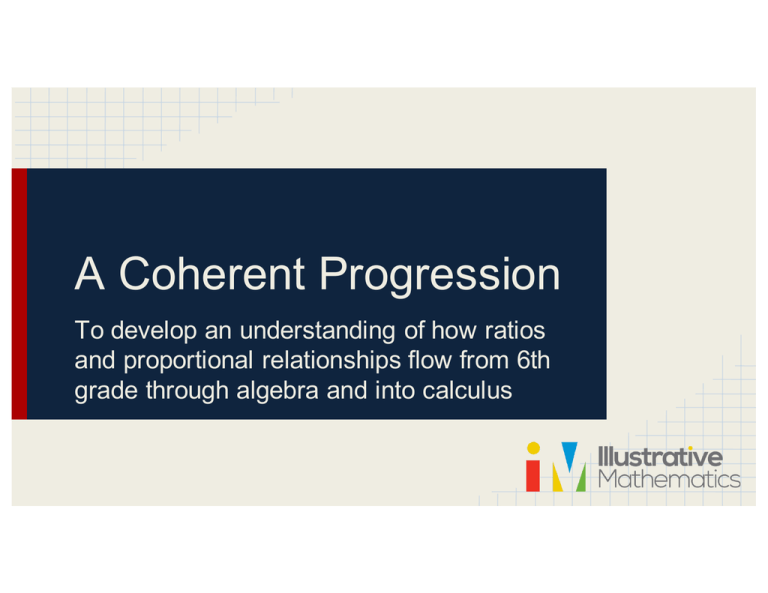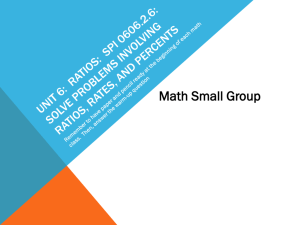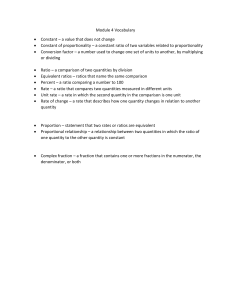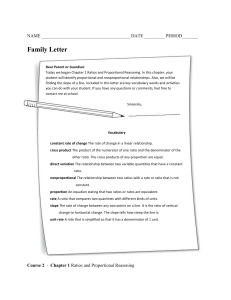A Coherent Progression
advertisement

A Coherent Progression To develop an understanding of how ratios and proportional relationships flow from 6th grade through algebra and into calculus Agenda ● Complete and discuss one 8th grade task involving ratio and proportion ● Make connections between 6th, 7th and 8th grade tasks ● Discuss a high school functions task and the prerequisite skills necessary from middle school Goals Participants will ● use the lens of rate of change to make connections between middle grades courses and into high school courses ● use these connections to better assist students on their paths toward a robust understanding of rate of change A task to start 8.EE Sore Throats Make connections Two Tasks: ● 6.RP Equivalent Ratios and Unit Rates ● 7.RP Cider vs Juice Make connections A Coherence Map Connect to high school Ratios and Fractions: Distinguishing the Difference Objective: Participantswillbeableto: • accuratelycreateandidentifyaratio, fractionandunitrate. • explainthedifferencebetweenaratio, fractionandunitrate. What is the difference between a ratio and a fraction? • Let’s listen to how students and staff define the difference in their own words. • As you watch listen for any additional misconceptions you hear in the student’s responses. Students and Staff's take on ratios vs. fractions Video Response What are additional misconceptions you heard from students/staff? Share with your elbow partner and using #NCMath2 Evaluating Ratio Statements: Juice Task • In groups of three or four, determine if each of the statements is true or false. • Use blocks to help discover the validity of the statements. • On chart paper, explain how/why you determined if each statement was true or false. Ratio • Ratios arise in situations in which two or more quantities are related In our task, orange juice to pineapple juice. • Quantities may be any measureable attribute, such as distance, area, weight, income, population • A measurable quantity can be described with a number and unit: Example: 3 cups Ratio cont. Quantities may have: 1. Same units: 3 cups orange juice and 2 cups pineapple juice 2. Different units that measure the same attribute: 3 meters and 2 feet 3. Units that measure different attributes: 3 meters and 2 seconds Ratio cont. Ratios can be expressed in multiple ways 1.Words • 3 to 2 • 3 for every 2 • 3 out of every 5 • 3 parts to 2 parts • 3 cups of orange juice for every 2 cups pineapple juice 2. Colon 3:2 Ratio cont. Since ratios relate two quantities, they are not a single number and cannot be placed on a number line Unit Rate The unit rate tells: ”For each 1…” “For every 1…” In other words, it tells how many times as large one quantity is compared to the other, and is thus a number, and may be a fraction Unit Rate The ratio 3 cups orange juice to 2 cups pineapple juice, has the unit rate: 3/2 cup orange juice for every 1 cup pineapple juice There is also an inverse rate, formed by switching the order of numbers in the ratio ⅔ cup pineapple juice for every 1 cup orange juice. Fraction A fraction is a single number that tells how many parts we have and into how many parts each whole has been partitioned. Since a fraction is a number, it can be shown on a numberline. Fraction In our task, the 2 and 3 cups can be combined since the units are the same unit of measurement. ⅖ of the cups are pineapple juice. ⅗ of the cups are orange juice. Fraction connected to Unit Rate A unit rate is also a fraction because it is a single number derived from the ratio. When you divide to find the unit rate, the quotient is called the value of the ratio. 3 divided by 2 is 3/2 3/2 is called the value of the ratio Creating A New Color Directions: 1.Use two colors of playdough. 2.Determine and keep track of how many tablespoons of each color you want to use. 3.Mix thoroughly, until you have a new color. 4. Write down your combination and develop a name for your new color. Creating a New Color On a post-it note, identify the following: -Part to part ratios -Part to whole ratios -Fractions -Two unit rates: “ For every 1 tablespoon _______, there is ________ tablespoons ___________.” Equivalent Ratios and Fractions Equivalent fractions name the same number. When we place equivalent fractions on a number line, they appear in exactly the same place. Equivalent ratios represent multiple GROUPS that each have the same composition. As we add groups, the total number of cups grows, but for every 1 group, ⅔ of the total is blue. The ratios 2:3, 4:6, 6:9 all have the same rate, ⅔, but represent different amounts of the two measured quantities. Equivalent Ratios and Fractions Equivalent fractions name the same number. When we place equivalent fractions on a number line, they appear in exactly the same place. Equivalent ratios represent multiple GROUPS that each have the same composition. As we add groups, the total number of cups grows, but for every 1 group, ⅔ of the total is blue. The ratios 2:3, 4:6, 6:9 all have the same rate, ⅔, but represent different amounts of the two measured quantities. Equivalent Ratios and Fractions Equivalent fractions name the same number. When we place equivalent fractions on a number line, they appear in exactly the same place. Equivalent ratios represent multiple GROUPS that each have the same composition. As we add groups, the total number of cups grows, but for every 1 group, ⅔ of the total is blue. The ratios 2:3, 4:6, 6:9 all have the same rate, ⅔, but represent different amounts of the two measured quantities. Ratio, Fraction, Unit Rate In your small groups, use the given notecards to brainstorm your current thoughts about each of the given terms: Fraction Ratio Unit Rate Reference using words, mathematics, etc. from the Juice Task and Playdough Color task when possible. -Tape your notecards to the bottom of your posters. Definitions From the Appendix of the Progression document: • A ratio is a pair of non-negative numbers, A : B, which are not both 0. • When there are A units of one quantity for every B units of another quantity, a rate associated with the ratio A : B is A/B units of the first quantity per 1 unit of the second quantity (Note that the two quantities can have different units). • The associated unit rate is A/B. Example: 6 meters per 2 seconds would have a unit rate of 6 meters/2 seconds or 3 meters for every 1 second. • The value of A:B is the quotient A/B, which may be expressed as a decimal, percent, fraction, or mixed number. • The value of the ratio A:B tells how A and B compare multiplicatively – it tells how many times as big A is as B. Fractions A fraction is a single quantity – a number that can be shown on a number line. Fractions definition from the Grade 3 standards: CCSS.MATH.CONTENT.3.NF.A.1 Understand a fraction 1/b as the quantity formed by 1 part when a whole is partitioned into b equal parts; understand a fraction a/b as the quantity formed by a parts of size 1/b. CCSS.MATH.CONTENT.3.NF.A.2 Understand a fraction as a number on the number line; represent fractions on a number line diagram. Ratios & Proportional Relationships Playlist The progression of representations in the RP domain Goals 1. Develop an understanding of the progression of visual representations in the CCSS Ratio and Proportional Relationships Domain through illustrative tasks. 2. Develop an understanding of the depth of the expectations in sixth and seventh grade ratio and proportional relationships domain through an analysis of the language of the CCSS. Let’s do some math! A: Tomato Tomahto B: Feeding a Crowd C: Equivalent Ratios D: Centimeters & Millimeters E: Art Class F: Same and Different 1. At your tables, split into 2 groups 2. Each group, deal out a task to each person Let’s do some math! A: Tomato Tomahto B: Feeding a Crowd C: Equivalent Ratios D: Centimeters & Millimeters E: Art Class F: Same and Different 1. Do the task… • • • What do you notice? What’s it getting at? How might students approach this? 2. Share your observations with your group mates Personal Reflection • What’s the role and development of visual representations in the ratios and proportional relationships domain? • Write down notes... “What I think” column Create a Playlist A: Tomato Tomahto B: Feeding a Crowd C: Equivalent Ratios D: Centimeters & Millimeters E: Art Class F: Same and Different Playlist Considerations • How would you order these tasks, and why? –Consider the numbers –Consider the representations –Consider the language • Which tasks are appropriate for grade 6? Which are appropriate for grade 7? Why? Be prepared to share your group’s rationale. Let’s dive in! Reading Marks !- surprising *- important ?- I wonder Ratios and Proportional Relationships Ratios and Proportional Relationships 6.RP.A: Understand ratio concepts and use ratio reasoning to solve problems. 3. Use ratio and rate reasoning to solve real-world and mathematical problems, e.g., by reasoning about tables of equivalent ratios, tape diagrams, double number line diagrams, or equations. 7.RP.A: Analyze proportional relationships and use them to solve real-world and mathematical problems. 2. Recognize and represent proportional relationships between quantities. Our Order 1. Tomato Tomahto 2. Art Class 3. Same and Different 4. Equivalent Ratios 5. Feeding a Crowd 6. Centimeters and Millimeters Our Reasoning • Tomato Tomahto –Very simple, almost literal diagrams. –Introduces students to the idea of representing a context with a ratio. • Art Class –Double tape diagram helps transition from literal or set diagrams to double number lines. –Purposefully expands use of ratio and rate language. Our Reasoning Same and Different • Double number lines are more abstract than previous diagrams but still support reasoning using the geometric structure and the intuitive understanding of equivalent ratios. • Focuses attention on the three relevant quantities in the context (quantity A, quantity B, unit rate A/B). Equivalent Ratios • Introduces a more abstract definition of equivalent ratio (e.g., a : b is equivalent to any sa : sb for positive s). • Students now have access to all diagram types to support understanding of this more abstract definition. Our Reasoning Feeding a Crowd • Introduces ratio tables—the most abstract representation. Requires an abstract understanding of equivalent ratios in order to use with understanding. • Draws attention to the two possible unit rates in a context. Centimeters and Millimeters • Takes students to the next level of abstraction: proportional relationships. • This is the only task that is clearly grade 7. All other tasks are appropriate in grade 6, but could be adapted for grade 7 if they are used to help students understand proportional relationships. Fine-grained Progressions Grade 6 • Ratio • Equivalent ratios characterized by scale factor definition • Equivalent ratios characterized by unit rates Grade 7 • Proportional relationships Personal Reflection 2 • What’s the role and development of visual representations in the ratios and proportions domain? • Write down notes... “What I now know” column Building Capacity Next Steps • As facilitators of this module, how would you use this module? • Write down notes... “Where I go from here” column





